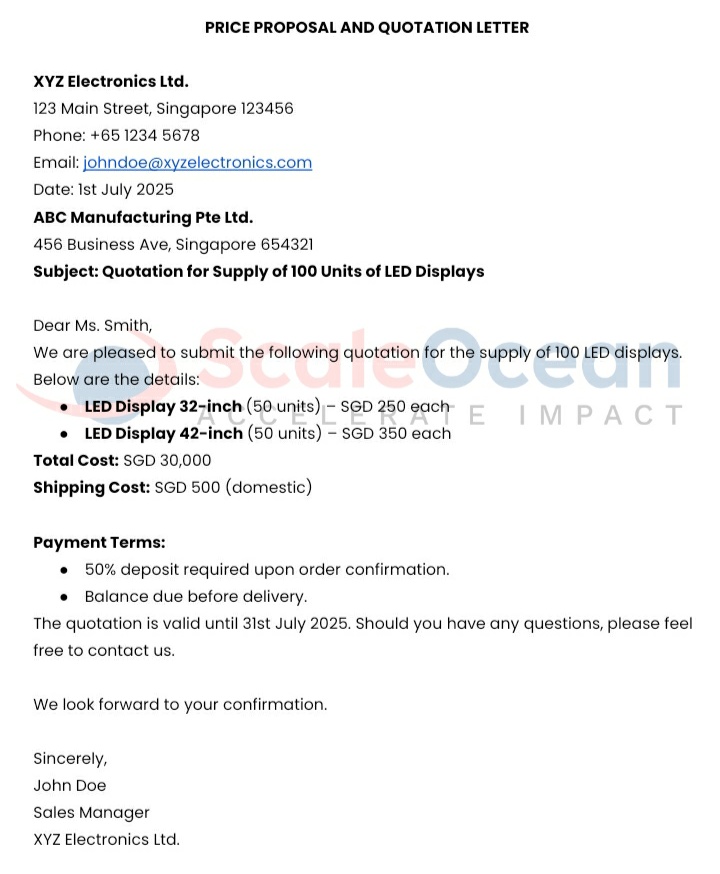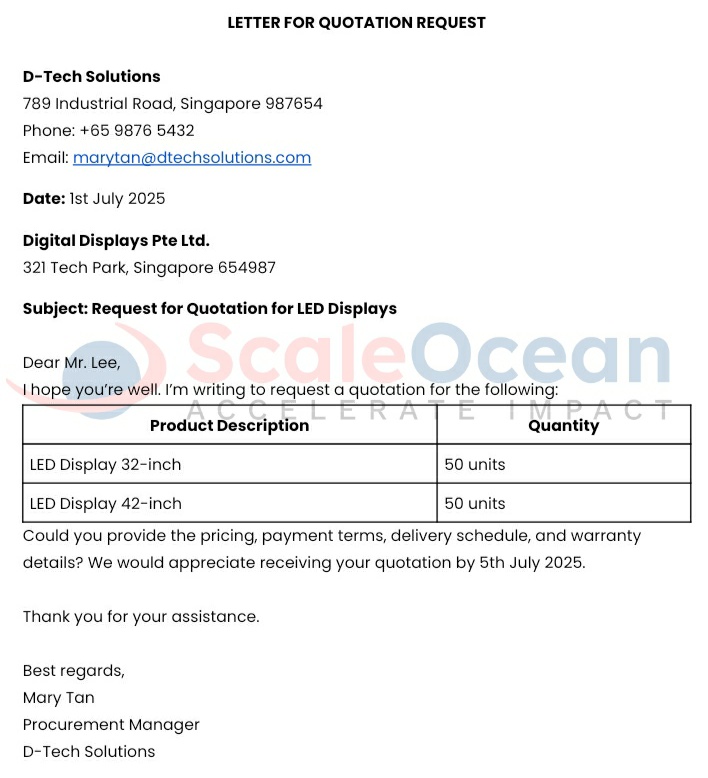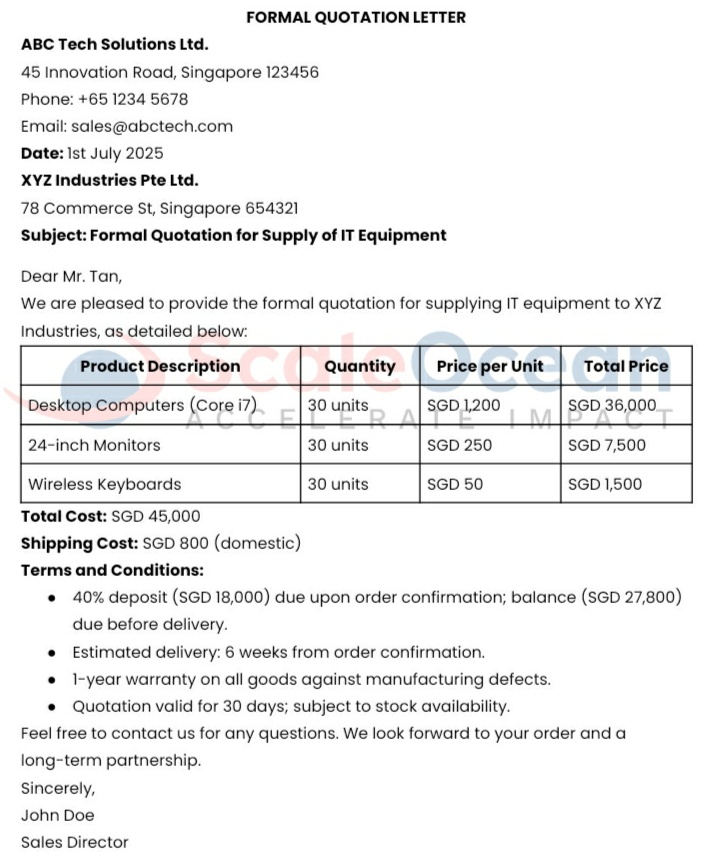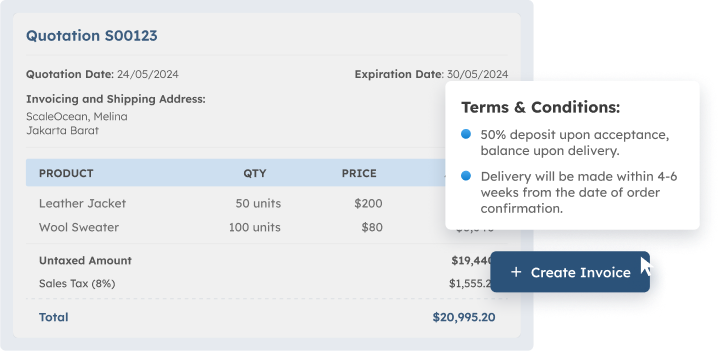Automating the quotation process is critical for Singapore organizations since it increases productivity and accuracy while minimizing human mistake. In a competitive market, having a system that swiftly creates accurate quotations can help firms reply to clients faster, resulting in higher customer satisfaction and profitability.
This article addresses the benefits of automated quotations as well as how technology may be used to streamline corporate procedures. It discusses major features, implementation processes, and how automation increases efficiency, making it required reading for business leaders trying to improve operations and remain competitive.
- A quotation letter is a formal document from a seller to a buyer, outlining the prices, terms, and conditions of the goods or services being offered, ensuring clear communication and setting expectations.
- Types of quotation letters vary based on the transaction’s formality, with businesses often using business, formal, and quotation enquiry letters to suit different needs.
- To write a quotation letter, it’s essential to include clear contact information, a defined subject line, a greeting, purpose, detailed offer, payment terms, and a professional call to action, ensuring all components are well-organized.
- ScaleOcean sales management automates the process of generating quotations by integrating key business functions, enhancing data accuracy, reducing manual effort, and streamlining financial and sales reporting for better decision-making.

What is a Quotation Letter?
A seller sends a quotation letter to a possible buyer that includes extensive information on the prices, terms, and conditions of the goods or services they provide. Businesses frequently use it in transactions to ensure clear communication about the cost structure, payment conditions, supply dates, and other essential elements. By detailing these parameters, the seller ensures that the buyer understands exactly what to expect in terms of both cost and product/service scope.
This letter is critical to developing trust and transparency between the buyer and seller. It establishes explicit expectations, preventing misunderstandings about the agreement. A well-written quote letter also serves as a reference point for both parties in case any problems emerge during the transaction. In a competitive industry, giving accurate and fast quotations can help firms differentiate themselves and build long-term client relationships.
Types of Quotation Letters
Quotation letters can vary depending on the nature and formality of the transaction. The following are the sorts of quote letters that businesses typically utilize:
1. Business Quotation Letter Sample
This sort of quotation letter is commonly used in routine transactions where a buyer requests price on a certain product or service. It contains detailed information such as the quantity of things, price per unit, delivery terms, and payment conditions. This form of letter is often easy and focused on delivering all of the details required for both parties to reach a clear and simple agreement.
2. Formal Quotation Letter
Businesses use a formal quotation letter when they require a more professional and organized approach. Companies frequently use it in circumstances involving larger organizations or corporate clientele who need precise, unambiguous, and professional communication, often as part of preparing a sales contract. These letters are more thorough and frequently use legal or contractual language to fulfill the formal expectations of the parties involved, maintaining a professional tone throughout the process.
3. Quotation Enquiry Letter
The buyer typically sends a quotation enquiry letter to the vendor, requesting comprehensive price information. This type of letter typically includes questions about the price of goods or services, terms of sale, and availability. After receiving a quotation enquiry letter, the seller responds with a formal quotation letter that includes all of the desired details as well as pricing and terms.
Components in a Quotation Letter

A quotation letter is a formal communication between a seller and buyer, outlining the price, terms, and conditions of an offer. It should be well-structured to ensure clarity and avoid misunderstandings. According to GeBIZ, quotations are used for goods or services valued up to $90,000, inviting competitive bids for such projects. The following are the main components to include in a quote letter:
1. Contact Information
The contact details for both the buyer and the seller should clearly state their information at the start of the letter. This includes the company’s name, address, phone numbers, and email addresses. Providing this information allows the two parties to communicate easily if either requires follow-up or explanations.
2. Date
The date on which the quotation was issued should always be specified. This informs the buyer about the exact time frame for which the prices and terms are valid. It also ensures that both parties understand when the seller made the offer, avoiding any uncertainty about out-of-date pricing or terms.
3. Introduction
The quotation letter’s introduction should provide a brief explanation of its aim. This section should clarify that the document is a response to a pricing request and summarize the major points of the offer. It establishes the tone for the remainder of the letter by summarizing the main points that will follow.
4. Details of Goods or Services
This part describes the products or services you are offering, including their descriptions, quantities, and any other pertinent information. You must be specific here, as the buyer must comprehend exactly what you are charging. Providing clear descriptions avoids misconceptions throughout the transaction and ensures both parties are aligned on the pricing. A clear breakdown also highlights the profit margin, helping the seller assess if the pricing strategy meets their goals.
5. Price Details
The pricing of the items or services should be explicitly stated in this area. This includes any relevant taxes, discounts, or other expenses, such as shipping or handling costs. Businesses may also refer to their profit and loss statement to ensure that pricing aligns with their financial goals. Pricing transparency promotes trust and ensures that all parties understand the costs involved.
6. Terms and Conditions
In this area, the seller should include any terms and conditions linked with the sale. This could include payment terms, delivery timetables, and warranty details. Outlining these data clearly ensures that the customer understands their commitments, such as payment deadlines or estimated delivery dates.
7. Validity Period
A quotation should always specify the time period for which the offer is valid. This helps to minimize uncertainty regarding whether the listed prices or terms will change after a specified time period. It establishes defined boundaries and offers the buyer a timeline in which to make a decision.
8. Conclusion
The conclusion should express the seller’s desire to continue negotiations or answer any inquiries. It should also include contact information again to make it easier for the buyer to follow up. This ending should be polite and professional, demonstrating the seller’s willingness to continue the conversation.
How to Write a Quotation Letter?
A quotation letter must be clear and professional, as it is sometimes the first formal communication between a seller and a customer. A well-written quotation letter can help firms express critical data about the pricing, terms, and conditions, thereby setting clear expectations. To write an effective quote letter, follow these steps:
1. Start with the Contact Information
Begin the letter by listing the seller’s and buyer’s contact information. This includes the company’s entire name, address, phone numbers, and email addresses. Ensuring that this information is correct will avoid confusion and allow both parties to interact effectively throughout the process.
2. Provide a Clear Subject Line
The subject line should be brief but effective in conveying the letter’s aim. It should let the receiver to quickly recognize the contents of the letter. A basic example can be: “Quotation for [product/service]”. This establishes the tone and primes the recipient for the information that follows.
3. Open with a Greeting
Always start your quotation letter with a nice, professional hello. Use the recipient’s name or an appropriate title, like “Dear [Recipient’s Name],”. A friendly and courteous greeting sets a favorable tone for the rest of the letter and contributes to the development of a professional relationship.
4. Introduce the Purpose
Explain why you’re using the quote in the first paragraph. Make it clear what product or service you’re offering, and explain that you’ll provide the desired pricing details. This quickly establishes the letter’s goal and provides the recipient with an idea of what to expect.
5. List the Details
Give a detailed yet succinct explanation of the items or services you offer. Be specific about the numbers, features, and variations of the objects. If applicable, mention unit prices and total costs to give a clear picture of the offer. This ensures that the consumer understands exactly what they are obtaining.
6. Include Payment Terms and Conditions
Outline the payment terms and any other significant criteria, such as delivery dates, warranties, or service terms. This could also include how invoicing is handled. Businesses can simplify this process by integrating invoicing software, which helps streamline billing and ensure that payments are accurately tracked and processed. Being open about these terms helps to minimize future confusion or arguments.
7. Close with a Call to Action
End the letter with a polite and professional call to action. Express your interest in proceeding by expressing anything like “We look forward to your confirmation.” This motivates the recipient to take action while also demonstrating that you are open to more talks or explanations.
8. Sign the Letter
Finish the letter with a professional closure, like “Sincerely” or “Best regards,” followed by your entire name and title. This personalizes the message while also reinforcing its professionalism. It also ensures that the receiver understands who is accountable for the offer.
Sample Quotation Letters
Quotation letters let firms properly convey prices, terms, and conditions for goods and services. They give transparency and ensure that both parties understand the expectations for the transaction. These letters come in a variety of formats depending on the goal, such as a price suggestion or a request for a quotation. Here are two sample quotation letters that show how to format and describe such documents:
1. Sample Price Proposal and Quotation Letter
A Sample Price Proposal and Quotation Letter outlines the pricing, terms, and conditions for a product or service. In the example above, XYZ Electronics Ltd. provides a detailed quotation for LED displays, including prices for both the 32-inch and 42-inch models, total cost, and shipping fees. It also specifies payment terms, such as a 50% deposit and a validity period for the quotation, ensuring clear expectations between both parties. Below is the sample of this type of letter:

2. Sample Letter for Quotation Request
A Sample Letter for Quotation Request is used by a buyer to formally request a quotation from a seller. In this example, D-Tech Solutions is asking Digital Displays Pte Ltd. for pricing on LED displays, specifying the desired quantities for both the 32-inch and 42-inch models. The letter also requests additional details such as payment terms, delivery schedules, and warranty information. This type of letter helps businesses get all the necessary information to make informed purchasing decisions. Below is a sample of this request letter:

3. Sample Formal Quotation Letter
A Sample Formal Quotation Letter provides a detailed and professional offer, often used in larger transactions or corporate settings. It includes not only the price but also terms of agreement, delivery schedules, and other contractual elements to ensure both parties are fully informed before proceeding. In this example, ABC Tech Solutions Ltd. offers a formal quotation to XYZ Industries Pte Ltd. for the supply of IT equipment, specifying quantities, pricing, and payment terms. Below is the sample letter:

Create Automated Quotations with ScaleOcean Sales Software

ScaleOcean’s sales management application has a comprehensive solution that streamlines business activities across multiple departments, including finance, inventory, procurement, and sales.
By consolidating diverse activities onto a single platform, it improves visibility, decision-making, and efficiency for organizations of all sizes. ScaleOcean provides benefits such as higher automation, reduced operational costs, and improved team collaboration.
ScaleOcean gives managers real-time data access, allowing them to make faster, more informed decisions. This method helps to address both operational needs and long-term strategic objectives. We offer a free demo to individuals who are interested in exploring its full capability, and ScaleOcean’s solutions are qualified for the CTC award, which will provide additional help to your firm. The following are the main features of ScaleOcean software:
- Comprehensive All-in-One Solution, ScaleOcean integrates key business functions like finance, inventory, procurement, and sales, streamlining operations and eliminating the need for multiple systems.
- Real-Time Data Access for Informed Decision-Making, Access real-time data for faster, data-driven decisions, optimizing processes and improving strategic planning.
- Cost-Efficiency Through Automation, Automate routine tasks to reduce manual work, minimize errors, and increase operational efficiency, leading to higher profitability.
- Scalability for Businesses of All Sizes, ScaleOcean grows with your business, offering flexible, customizable solutions suitable for both small startups and large enterprises.
- Streamlined Sales Process with Automated Quotations and Orders, Automate quotations and sales orders, enabling quicker responses, reducing errors, and enhancing customer satisfaction.
Conclusion
Automating the quotation process provides considerable benefits to businesses, such as faster response times, increased accuracy, and less administrative burden. Businesses in Singapore can use technology to streamline processes, boost customer satisfaction, and eventually increase profitability. An effective and dependable automated quote system is critical for remaining competitive in today’s fast-paced market.
ScaleOcean provides a comprehensive sales management solution that works smoothly with automated quote systems. This system enables organizations to manage their sales pipeline, track customer interactions, and quickly generate correct quotes all from one platform. ScaleOcean’s sales management system may help firms increase productivity and ensure a smoother, more effective workflow.
FAQ:
1. What is a quotation letter?
A quotation letter is a formal document from a seller to a potential buyer, detailing prices, terms, and conditions for a product or service. It clarifies the cost per unit, additional charges, and delivery terms, ensuring both parties understand the transaction. This letter sets clear expectations and helps avoid confusion. A well-written quotation builds trust and transparency between the seller and the buyer.
2. What does it mean to call for a quotation letter?
Calling for a quotation letter means requesting a detailed price quote from a seller or supplier. It involves asking for pricing, delivery timelines, and other terms. The buyer seeks to evaluate the offer before making a decision. This helps compare offers and choose the best one.
3. What is a quotation example?
An example of a quotation typically includes a breakdown of the price, quantity, and terms for specific goods or services. For example, a seller might provide a quote for “50 units of 32-inch LED displays at $250 each,” which would include the total price, any applicable shipping charges, and delivery timeframes. Additionally, the quotation would outline payment terms, such as a deposit requirement or payment upon delivery. This example gives the buyer a clear picture of the costs involved and the terms they can expect if they proceed with the offer.
4. How do you quote in a letter?
To quote in a letter, start by clearly stating the reason for providing the quote, such as in response to a request. Then, present the pricing details, including unit prices, quantities, and any additional costs like taxes or shipping fees. Be sure to include payment terms, delivery schedules, and other important conditions that apply to the offer. It’s important to make the quotation clear and precise, providing all relevant details to help the recipient understand the offer and make an informed decision.








 PTE LTD..png)
.png)

.png)








.png)
.png)
















